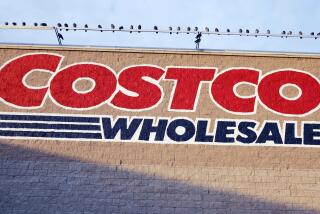RETAILERS COPE WITH TOUGH TIMES : A New Phase of Competition for Warehouses
- Share via
After exploiting nearly all of the “virgin” territory in metropolitan areas throughout the country, the major membership warehouse chains have been forced to slug it out in regions where their competitors are already entrenched.
The blood has already begun to flow in cities such as Denver and Philadelphia, where San Diego-based Price Co. is going head-to-head with Sam’s Club and Pace Membership Warehouse. The only big player not in those markets is Costco Wholesale.
Although the membership warehouse industry has weathered the recession remarkably well, the 24% tumble of Price Co. stock last week shows how nervous Wall Street is about the discounters’ new, tougher phase of competition--and whether Price can retain its crown as industry leader and bellwether.
Price’s stock dropped after it announced its first decline in quarterly profits, a decrease that it attributed in part to losses at recently opened Price Clubs in Denver, New Jersey and Connecticut, where the competition is intense.
The decline--and Price’s disclosure that it was reconsidering its high-growth strategy--sent the company’s shares down $10.75, or 24%, last Friday, when it closed at $35 in over-the-counter trading.
Intense competition is a whole new environment for an industry that is not geared to high-decibel marketing campaigns. So far, the chains have contented themselves with simply getting the word out to potential members through direct mail.
Membership warehouses are cash-and-carry operations that are typically open only to what are deemed low credit risks: business owners and employee groups such as government workers, teachers and credit union members.
Price Co. founder Sol Price, now retired, virtually invented the industry in 1976. By 1991, the industry had grown to 13 chains with 484 warehouses and sales totaling $27.9 billion, a 31% annual growth rate since 1986. And most analysts expect the industry to keep booming over the next decade, reaching 1,000 warehouses by 1996.
Until now, Price, which operates 78 Price Clubs and posted $6.76 billion in sales last year, has been the clear leader in the industry, setting standards for volume and merchandising against which all of its competitors were measured.
But Price has been slipping on some score cards. It lost its overall sales title this year to Sam’s Club, the membership warehouse division of Wal-Mart, which reported $9.43 billion in sales for the 12 months ended Jan. 31. Long thought the canniest, most cost-conscious of chains, Price’s 1991 gross profit margin of 8.86% of sales was surpassed by Costco’s 9.1% last year.
Montgomery Securities retail analyst Bo Cheadle said Price’s merchandising aura has dimmed, noting that Price was slow to see the wisdom of Costco’s move into fresh produce, meats and baked goods. Although those goods were outside the realm of Price’s original concept, the fresh food achieved a primary goal of the discounters: getting members to make more frequent shopping trips.
“The thing is, if you can get people to come in more frequently, you add an extra dimension to your business,” Costco President James Sinegal said. “You get them trading with you on a more continuous basis than if they were casual shoppers coming in every six weeks or so.”
Price Co.’s per-store average volume, a seemingly unmatchable $115 million two years ago, has been slipping. Price is now doing “between $100 million and $110 million” per store, Price President Mitchell Lynn said Wednesday, while Costco’s average was up to $81 million in 1991 from $76 million in 1990. Montgomery Securities’ Cheadle expects Costco to match Price’s per-store volume by 1995.
Its chief competitors, particularly Sam’s Club and Pace Membership, have taken a much more aggressive growth stance than Price. Since 1986, Sam’s Club, which now operates 212 membership warehouses, has opened 189 stores; Pace Membership has opened 72; Costco has opened 58 new outlets, and Price has opened 53.
And Sam’s Club has proven that Price’s approach of only going into markets with huge population bases is not the only key to profitable expansion. Colon Washburn, Sam’s Club executive vice president of merchandising, said the Sam’s Club store in Fargo, N.D., for example, draws customers who commute up to four hours to shop. Sam’s Club recently opened an outlet in Farmington, N.M., which has a population of only 10,000.
Until 1988, Price was roundly criticized for expanding too slowly, giving up the opportunity to be first in several metropolitan areas to faster, more nimble competitors. Then Price recognized the error of its approach and disclosed an aggressive expansion plan to grow from 69 clubs in August, 1991, to as many as 100 outlets by the end of 1992.
But last Friday Price did a turnabout, saying it was reconsidering its expansion strategy in light of disappointing results in the new markets. That pronouncement, as much as the earnings decline, was responsible for the sell-off in the stock, said Daniel Barry, retailing analyst with Merrill Lynch & Co. in New York.
“I think they are making a strategic mistake to cut back their expansion,” Barry said, adding that Price needs to grow rapidly to compensate for the market share it will inevitably lose in Southern California and elsewhere “as more competition enters their areas.”
Warehouses on the Warpath
The number of membership warehouse retail outlets has grown remarkably in less than a decade. Sam’s Club leads the way with more than double the outlets of its closest competitor.
(Chart compares the number of Sam’s Club retail outlets with: Price Club, Costco Wholesale and Pace Membership Warehouse.) Sam’s Club:
1985 = 11 outlets
Currently = 212 outlets
Source: The companies
More to Read
Inside the business of entertainment
The Wide Shot brings you news, analysis and insights on everything from streaming wars to production — and what it all means for the future.
You may occasionally receive promotional content from the Los Angeles Times.










